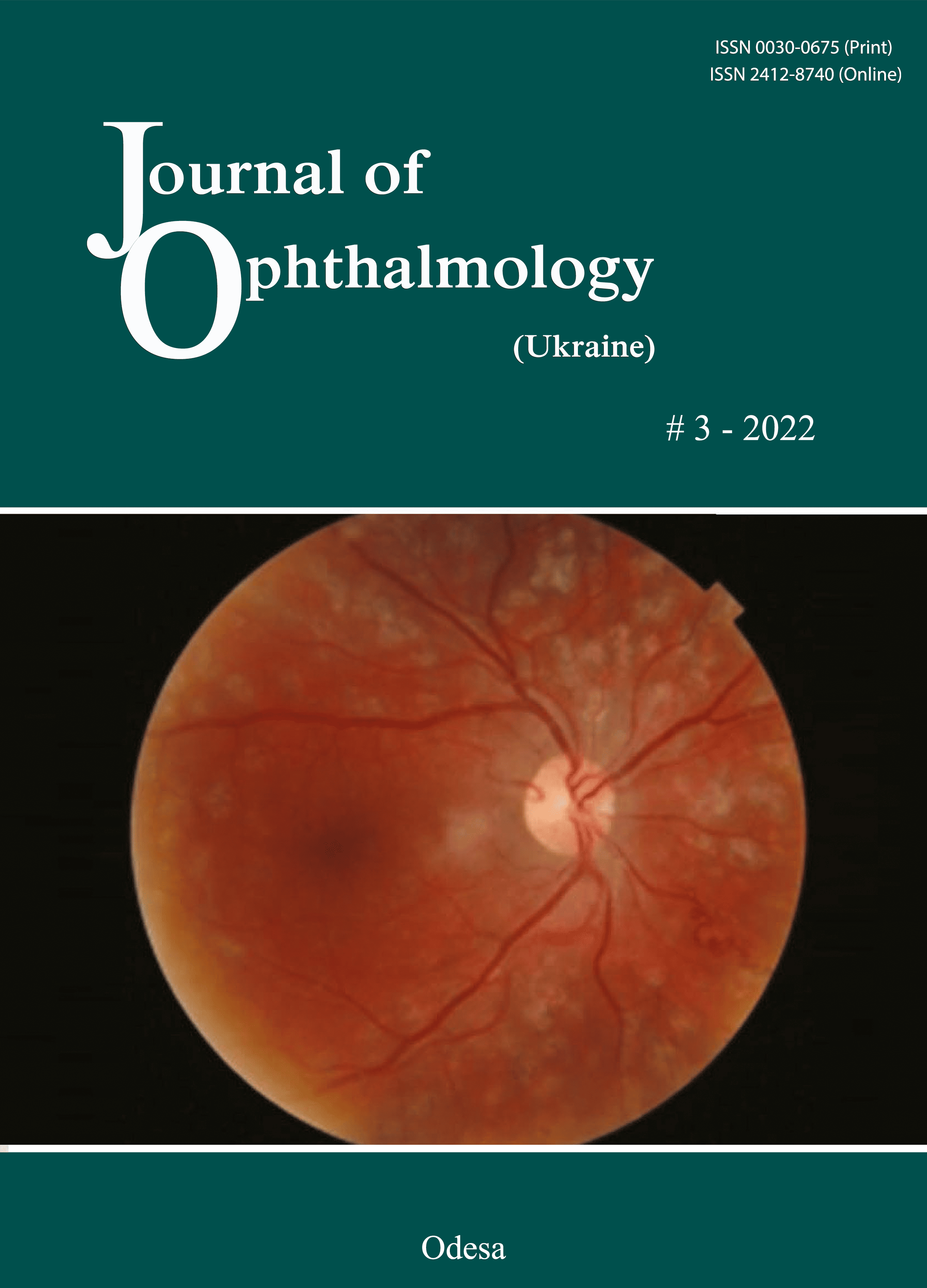Changes in clinical and biochemical characteristics in combination treatment for diabetic macular edema
DOI:
https://doi.org/10.31288/oftalmolzh202231823Keywords:
diabetic macular edema, aflibercept, hyperbaric oxygen therapy, enzymesAbstract
Background: Diabetic macular edema (DME) can be seen in both types of diabetic retinopathy (DR), and is a major cause of vision loss.
Purpose: To evaluate the efficacy of the combination treatment for DME in type 2 diabetic patients with non-proliferative diabetic retinopathy (NPDR).
Material and Methods: An open-label, controlled study included 45 type 2 diabetic patients with both NPDR and DME. Patients of the aflibercept-plus-hyperbaric oxygen (HBO) group and those of the aflibercept-only (control) group received a monthly intravitreous aflibercept at a dose of 2 mg (50 µL) for 3 months. In addition, the former patients received an adjunctive treatment with ten sessions of HBO in the period between the first and the third injections. Changes in clinical and biochemical characteristics were assessed at 3 months after initiation of treatment.
Results: At 3 months, patients of the aflibercept-plus-HBO group showed a statistically significant improvement in visual acuity, improvement in retinal light sensitivity, reduction in manifestations of DME, and statistically significant reductions in blood glucose and glycated hemoglobin levels. At 3 months, the changes in the activities of antioxidant enzymes were more substantial in this group, and these improvements were statistically significant compared to baseline and compared to controls. Particularly, superoxide dismutase (SOD) activity, catalase (CAT) activity, and glutathione reductase (GSR) activity decreased by 33.9%, 22.4% and 17.7%, respectively, compared to baseline, and 34.78%, 28.9%, and 25.3%, respectively, compared to controls.
Conclusion: Treatment for DME with the use of aflibercept and adjunctive HBO caused a substantial reduction in the frequency of DME and improvements in visual acuity and retinal light sensitivity in type 2 diabetic patients NPDR. Under these conditions, a decrease in the activity of CAT was larger than that of GSR but smaller than that of SOD, likely indicating an improvement in antioxidant protection.
References
1.Warboys C, Fraser P. Hyperglycemia attenuates acute permeability response to advanced glycation end products in retinal microvasculature. Microvasc Res. 2010 Jul;80(1):174-6. https://doi.org/10.1016/j.mvr.2010.03.004
2.Browning D, Stewart M, Lee Ch. Diabetic macular edema. Evidence-based management. Indian J Ophthalmol. 2018 Dec;66(12):1736-50. https://doi.org/10.4103/ijo.IJO_1240_18
3.Browning DJ, Fraser CM, Clark S. The relationship of macular thickness to clinically graded diabetic retinopathy severity in eyes without clinically detected diabetic macular edema. Ophthalmology. 2008 Mar;115(3):533-539.e2. https://doi.org/10.1016/j.ophtha.2007.06.042
4.Yu DY, Cringle SJ, Su E, Yu PK., Humayun MS, Dorin G, et al. Laser induced changes in intraretinal oxygen distribution in pigmented rabbits. Invest Ophthalmol Vis Sci. 2005 Mar;46(3):988-99. https://doi.org/10.1167/iovs.04-0767
5.Stefánsson E. Ocular oxygenation and the treatment of diabetic retinopathy. Surv Ophthalmol. Jul-Aug 2006;51(4):364-80. https://doi.org/10.1016/j.survophthal.2006.04.005
6.de Andrade GC, de Oliveira Dias JR, Maia A, Farah ME, Meyer CH, et al. Intravitreal ziv aflibercept for diabetic macular edema: 48 week outcomes. Ophthalmic Surg Lasers Imaging Retina. 2018 Apr 1;49(4):245-250. https://doi.org/10.3928/23258160-20180329-06
7.Ivankiv IaI, Oleshchuk OM, Datsko TV, Fedoniuk LIa. [Characteristics of prooxidative-antioxidative homeostasis, carbohydrate metabolism and morphological changes in the liver under conditions of melatonin injection in experimental type 2 diabetes]. Visnyk morphologii. 2016;22(2):253-8. Ukrainian.
8.Rykov SO, Vydyborets SV. [Glycated proteins, oxidative stress and interleukins: risk factors for the onset and progression of diabetic retinopathy]. Arkhiv oftalmologii Ukrainy. 2019;7(1):81-5.
9.Noma H, Yasuda K, Shimura M. Involvement of Cytokines in the Pathogenesis of Diabetic Macular Edema. Int J Mol Sci. 2021. 2021 Mar 26;22(7):3427. https://doi.org/10.3390/ijms22073427
10.Bokhary K, Aljaser F, Abudawood M. Role of Oxidative Stress and Severity of Diabetic Retinopathy in Type 1 and Type 2 Diabetes. Ophthalmic Res. 2021;64(4):613-621. https://doi.org/10.1159/000514722
11.Kowluru RA., Chan PS. Oxidative stress and diabetic retinopathy. Exp Diabet Res. 2007;2007:43603. https://doi.org/10.1155/2007/43603
12.Case AJ. On the Origin of Superoxide Dismutase: An Evolutionary Perspective of Superoxide-Mediated Redox Signaling. Antioxidants (Basel). 2017 Oct 30;6(4):82. https://doi.org/10.3390/antiox6040082
13.Giordano CR, Roberts R, Krentz KA, et al. Catalase therapy corrects oxidative stress-induced pathophysiology in incipient diabetic retinopathy. Invest Ophthalmol Vis Sci. 2015 May;56(5):3095-102. https://doi.org/10.1167/iovs.14-16194
14.Kowluru RA, Atasi L, Ho YS. Role of mitochondrial superoxide dismutase in the development of diabetic retinopathy. Invest Ophthalmol. Vis Sci. 2006. 2006 Apr;47(4):1594-99. https://doi.org/10.1167/iovs.05-1276
15.Resanović I, Zarić B, Radovanović J, et al. Hyperbaric oxygen therapy and vascular complications in diabetes mellitus. Angiology. 2020 Nov;71(10):876-85. https://doi.org/10.1177/0003319720936925
16.Baitule S, Patel AH, Murthy N. A systematic review to assess the impact of hyperbaric oxygen therapy on glycaemia in people with diabetes mellitus. Medicina (Kaunas). 2021 Oct 19;57(10):1134. https://doi.org/10.3390/medicina57101134
17.Satoh N, Watanabe N, Kanda A, Sugaya-Fukazawa M, Hisatomi H. Expression of glutathione reductase splice variants in human tissues. Biochem Genet. 2010 Oct;48(9-10):816-21. https://doi.org/10.1007/s10528-010-9362-z
18.Petersmann A, Müller-Wieland D, Müller UA, et al. Definition, Classification and Diagnosis of Diabetes Mellitus. Exp Clin Endocrinol Diabetes. 2019 Dec;127(S 01):S1-S7. https://doi.org/10.1055/a-1018-9078
19.Wilkinson CP, Ferris FL, Klein RE, et al. Proposed international clinical diabetic retinopathy and diabetic macular edema disease severity scales. Ophthalmology. 2003 Sep;110(9):1677-82. https://doi.org/10.1016/S0161-6420(03)00475-5
20.Arjamaa O, Nikinmaa M. Oxygen-dependent diseases in the retina: Role of hypoxia-inducible factors. Exp Eye Res. 2006. 2006 Sep;83(3):473-83. https://doi.org/10.1016/j.exer.2006.01.016
21.Gupta A., Bhatnagar S. Vasoregression: a shared vascular pathology underlying macrovascular and microvascular pathologies? OMICS. 2015 Dec;19(12):733-53. https://doi.org/10.1089/omi.2015.0128
22.Maalej A, Khallouli A, Choura R, et al. The effects of hyperbaric oxygen therapy on diabetic retinopathy: A preliminary study. J Fr Ophtalmol. 2020. 2020 Feb;43(2):133-8. https://doi.org/10.1016/j.jfo.2019.07.005
Downloads
Published
How to Cite
Issue
Section
License
Copyright (c) 2025 В. О. Дроздов, В. М. Сакович

This work is licensed under a Creative Commons Attribution 4.0 International License.
This work is licensed under a Creative Commons Attribution 4.0 International (CC BY 4.0) that allows users to read, download, copy, distribute, print, search, or link to the full texts of the articles, or use them for any other lawful purpose, without asking prior permission from the publisher or the author as long as they cite the source.
COPYRIGHT NOTICE
Authors who publish in this journal agree to the following terms:
- Authors hold copyright immediately after publication of their works and retain publishing rights without any restrictions.
- The copyright commencement date complies the publication date of the issue, where the article is included in.
DEPOSIT POLICY
- Authors are permitted and encouraged to post their work online (e.g., in institutional repositories or on their website) during the editorial process, as it can lead to productive exchanges, as well as earlier and greater citation of published work.
- Authors are able to enter into separate, additional contractual arrangements for the non-exclusive distribution of the journal's published version of the work with an acknowledgement of its initial publication in this journal.
- Post-print (post-refereeing manuscript version) and publisher's PDF-version self-archiving is allowed.
- Archiving the pre-print (pre-refereeing manuscript version) not allowed.












